Conservation, community, and a love for big monkeys: Karen Strier celebrates 40-year study of Northern muriqui

Muriqui monkeys on a protected reserve in southeastern Brazil near the city of Caratinga. Since 1982, University of Wisconsin–Madison professor Karen Strier has worked to study the monkeys and protect their habitat, along with an ever-growing community of researchers and conservationists. Photo Credit: João Marcos Rosa
It’s 1982 and Karen Strier is walking uphill in a small, fragmented section of Brazil’s Atlantic Forest. Along with a few other scientists, she treks through the tropical humidity hoping to come across a critically endangered monkey – the Northern muriqui.
Suddenly, Strier hears a strange noise like a horse neighing from the valley down below and she sees, sitting in a beam of light on a branch in the trees, just what she’s come to find. As quickly as she spots it, the large, gray-brown, furry monkey gracefully swings off into the forest and disappears.
But a few seconds was all she needed.
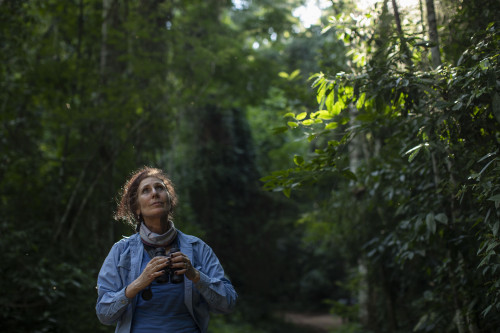
Karen Strier in the forest, January 2020. Photo Credit: João Marcos Rosa
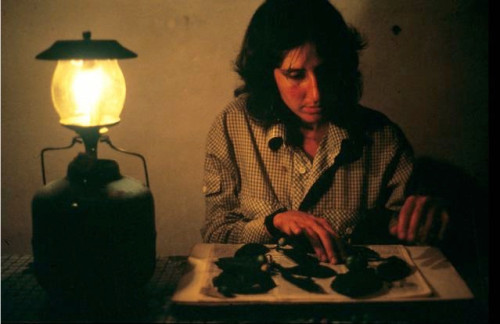
Karen Strier pressing plants for identification by gas lamp during her doctoral research in 1984, before electricity reached the field site. Photo Credit: Andy Young
“It was love at first sight,” Strier recalls while sitting in her office at the University of Wisconsin–Madison.
It’s 2023 and her office walls and shelves are covered in photos of the monkeys to whose study Strier has now dedicated decades of her life. On top of a filing cabinet sits a red, velvet box. Inside, a certificate of honorary citizenship from Caratinga, Brazil, testifies to her commitment to the region and its animals.
Strier’s first glimpse of the muriqui back in 1982 inspired a 40-year-long study built on decades of collaboration with Brazilian scientists and her passion to help conservation efforts for the monkeys.
“I’ve been in the field with her many times, and she’s always super excited when she sees them,” says Russel Mittermeier, primatologist and chief conservation officer of Re:Wild. “It’s delightful to see how much she cares about them. Her commitment is really unmatched.”
Mittermeier was with her on that first, fateful trek through the forest when she was introduced to the muriqui. At that point in her life, Strier had spent time as an undergraduate doing fieldwork with baboons, and she knew she wanted a career studying animals in the field. But until that day, she just wasn’t sure which ones.
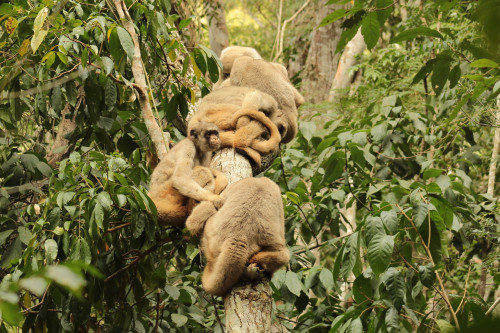
A group of northern muriquis sit together in a tree. The peaceful egalitarian structure of northern muriquis groups makes them different from many other groups of primates which tend to see more violence. Photo credit: Carla B. Possamai / Projeto Muriqui de Caratinga ©
“The muriquis were perfect because no one really knew anything about them,” Strier recalls. “And they were critically endangered, so that also meant that anything I learned about them would have value for conservation.”
Strier returned to the forest in 1983 and spent 14 months following the muriquis each day to observe and document how the animals interacted. She developed a way to identify individual monkeys based on their unique facial markings.
She has returned year after year for months at a time ever since.
Her field site is the 3.86 square mile Reserva Particular Patrimonio Natural – Feliciano Miguel Abdala, a protected area established by a family that owns the forest, named for the man who opened the land to Strier and other researchers when the study began.
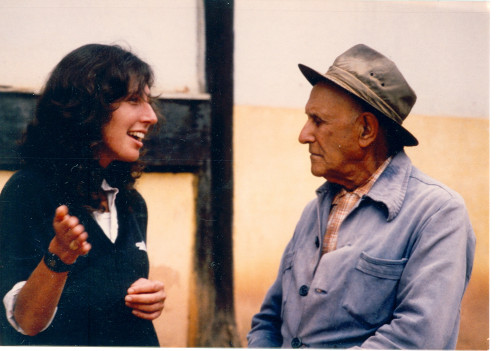
Karen Strier with the owner of the forest, Sr. Feliciano Miguel Abdala, in 1988. Sr. Feliciano preserved his forest and protected the muriquis, and welcomed Karen and other researchers on his property. Photo Credit: K.B. Strier / Projeto Muriqui de Caratinga ©
Studying the same population for so long has helped Strier and her team gain in-depth knowledge of how the endangered monkeys live, socialize and interact with their environment. This has proven crucial to informing the management guidance Strier and her colleagues provide the Brazilian government and nonprofit organizations to help with conservation efforts.
It’s also illuminated the ways in which muriquis are not like other primates.
While for instance baboons and chimpanzees engage in violence and aggression, the muriquis live in peaceful, egalitarian societies. Related males and their mothers make up the core of their groups, and as a female muriqui ages, she eventually leaves the group she was born into and finds another.
As Strier started to get to know the animals, “all the images of what primates were ‘supposed’ to do were changing in my mind,” she says.
This focused her on trying to better understand which behaviors are hard-wired in the monkeys and which are flexible: Why are the monkeys peaceful? If certain variables change, would they still be peaceful? How resilient are these animals to shifting climate conditions? Will those shifting conditions alter the way they behave?
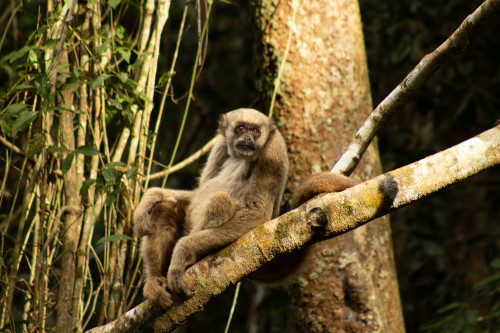
The northern muriquis have distinct facial markings that permit Strier and her team to recognize them individually. Photo credit: Carla B. Possamai / Projeto Muriqui de Caratinga ©
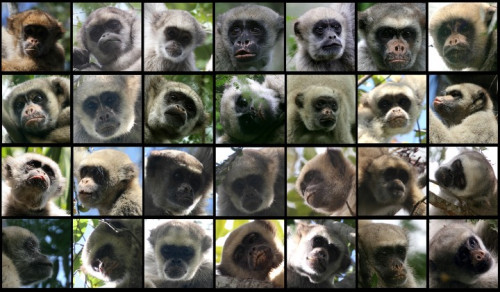
A selection of muriqui faces. Photo credit: Pablo Fernicola / Projeto Muriqui de Caratinga ©
Long-term data — like the observations collected by Strier and her colleagues — are rare and invaluable for answering these questions. So are the important reproductive insights they have gathered, which rely on approaches that are as minimally invasive for the animals as possible.
For instance, when it came to learning more about the monkeys’ reproductive cycles, she and Toni Ziegler, a scientist at the Wisconsin Regional Primate Research Center, turned to the best passive biological sample they could find: poop.
By combining Strier’s observational data with analysis of the fecal samples through methods developed by Ziegler and her team, they were able to measure various hormone levels in individual muriquis.
“Without ever catching or touching a muriqui, we deciphered their entire reproductive cycle,” Strier says. “Gestation is 7.2 months, cycles are 21 days apart and females usually experience between three and five ovarian cycles before they get pregnant.”
This knowledge has become especially important in recent years as she and colleagues try to diversify the gene pool of different muriqui populations. There are only 12 groups of the endangered monkey left on the planet, so these efforts are critical to the researchers’ conservation goals — goals that have become even more focused in recent years.
Over a period of six months in 2016 and 2017, a surge of yellow fever dramatically reduced the muriqui population by nearly 10%. Strier realized she needed to ensure not only that the team produced research with applications for conservation, but that they were also taking action to make that conservation happen.
One way the researchers are translating their findings into active conservation is by working with several groups to create forest corridors connecting the 12 muriqui populations, which currently live in forests fragmented by human development.
“The projection for climate change in this region is that it will get drier and hotter,” Strier says. “That means these animals need a place to go because they’re living in an island of forest.”
Connecting fragmented forests to one another could provide a safe corridor for populations of muriquis to move to other populations that live in wetter, cooler, protected forests. And Strier knows of one just 50 kilometers from the population she studies.
“My hope is to see these muriquis be able to move back and forth between these two established reserves, across a larger, connected protected area anchored by these, where they can interbreed with other muriquis and their population can continue to grow. If we can achieve this for the muriquis, we will have made a real difference,” she says.
The team is also integrating remote monitoring technologies into their work, like drones and motion sensor cameras placed in trees, to help researchers locate, track and observe the monkeys without physically being in the forests.
For decades, the researchers have essentially lived the lives of the muriquis, says Carla Possamai, a scientist who was drawn to the project 20 years ago by her desire to further conservation efforts and her curiosity about the muriquis’ reproductive and social behavior.
Over the years, dozens of rigorously trained researchers have identified and observed every new infant from the first days of its life until it disappears, all without radio collars, tagging or handling the animals. The study’s continuity has been built upon their decades of dedication. The new approaches — such as the use of camera traps and drones — bring additional dimensions.
“We have this really good quality data, but these new technologies can help increase the amount of data that we have,” Possamai says.
Possamai is just one of the Brazilian scientists Strier has worked with who became enamored of the monkeys while a student. Over the last 40 years, Strier has trained and mentored more than 80 Brazilian students, two-thirds of whom are still pursuing primatology, conservation or both.
The Brazilian government requires foreign researchers to work with a Brazilian collaborator on projects conducted in the country. Strier’s current Brazilian counterpart, Sérgio Lucena Mendes, has worked with primates in the area and swapped scientific ideas with Strier for the last 40 years, but their formal collaboration on the muriqui project began in the early 2000s.
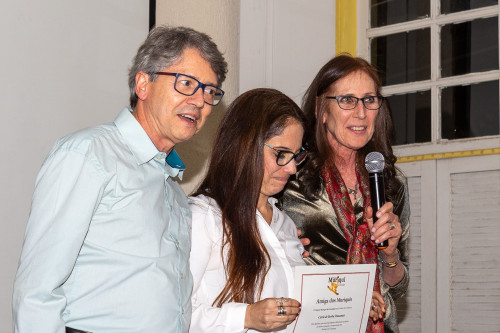
Karen Strier and her long-time friend and collaborator, Sérgio Lucena Mendes, honoring Carla Possamai for her years of dedication on the Muriqui Project of Caratinga during the opening ceremony of Caratinga+40 in 2023. Photo credit: Pablo Fernicola / Projeto Muriqui de Caratinga ©
“Talking and exchanging ideas with Karen is always enriching,” Mendes says, noting that it was her dedication that led him to the team.
Of her collaborators, Strier says, “These are all people who are completely committed to studying muriquis and to saving the species. I’m also really proud of how many people have participated on the project over the years. I had no idea it would grow so much.”
This summer at the field station in Brazil, Strier and her long-time colleagues at Conservation International-Brasil threw a 40-year celebration for the Caratinga community and about 120 of the people who have worked on the project throughout the years. Old friends, past and new collaborators, former students now holding important conservation positions and leaders from the Brazilian government and conservation groups all returned to celebrate together.
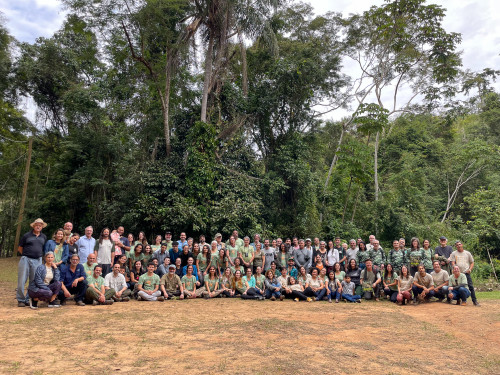
Strier (center) and some of the many former students, colleagues, and friends who joined in the 40th anniversary celebration, Caratinga+40. Photo credit: Pablo Fernicola / Projeto Muriqui de Caratinga ©
“I’m a great believer in the importance of long-term field stations. A field station like the one that we have at Caratinga plays an incredibly important role for conservation,” says Mittermeier, who also returned for the celebration.
At the root of Strier’s passion to protect the muriquis is the inspiration they give her for a better way of living. Many evolutionary anthropologists study primates in the hopes of finding answers to an age-old question: What does it mean to be human?
While chimpanzees, bonobos and gorillas are much more closely related to us evolutionarily, the muriquis are still part of our primate lineage, and Strier believes they give us an example of a way of life that’s completely different from our own — one that shows it is possible to live peacefully and to navigate tensions in social life with affection, tolerance and patience.
“When I think about what kind of person I want to be, I always end up thinking of the muriquis,” she says. “I guess you could say that I want to be more like a muriqui.”
Subscribe to Wisconsin Ideas
Want more stories of the Wisconsin Idea in action? Sign-up for our monthly e-newsletter highlighting how Badgers are taking their education and research beyond the boundaries of the classroom to improve lives.



